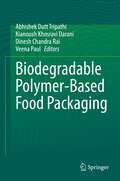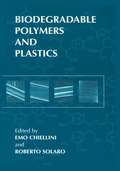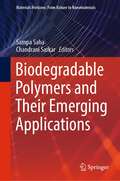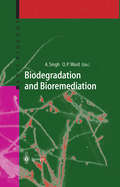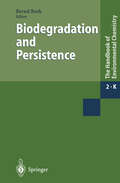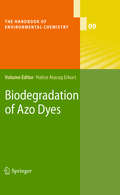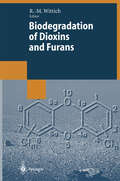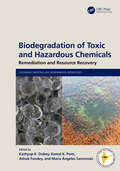- Table View
- List View
Biodegradable Poly (Lactic Acid): Synthesis, Modification, Processing and Applications
by Jie Ren"Biodegradable Poly (Lactic Acid): Synthesis, Modification, Processing and Applications" describes the preparation, modification, processing, and the research and applications of biodegradable poly (lactic acid), which belong to the biomedical and environment-friendly materials. Highly illustrated, the book introduces systematically the synthesis, physical and chemical modifications, and the latest developments of research and applications of poly (lactic acid) in biomedical materials.The book is intended for researchers and graduate students in the fields of materials science and engineering, polymer science and engineering, biomedicine, chemistry, environmental sciences, textile science and engineering, package materials, and so on.Dr. Jie Ren is a professor at the Institute of Nano and Bio-Polymeric Materials, School of Material Science and Engineering, Tongji University, Shanghai, China.
Biodegradable Polyesters: Homopolymers, Copolymers, Blends And Composites
by Stoyko FakirovCollating otherwise hard-to-get and recently acquired knowledge in one work, this is a comprehensive reference on the synthesis, properties, characterization, and applications of this eco-friendly class of plastics. A group of internationally renowned researchers offer their first-hand experience and knowledge, dealing exclusively with those biodegradable polyesters that have become increasingly important over the past two decades due to environmental concerns on the one hand and newly-devised applications in the biomedical field on the other. The result is an unparalleled overview for the industrial chemist and materials scientist, as well as for developers and researchers in industry and academia alike.
Biodegradable Polyesters
by Stoyko FakirovCollating otherwise hard-to-get and recently acquired knowledge in one work, this is a comprehensive reference on the synthesis, properties, characterization, and applications of this eco-friendly class of plastics. A group of internationally renowned researchers offer their first-hand experience and knowledge, dealing exclusively with those biodegradable polyesters that have become increasingly important over the past two decades due to environmental concerns on the one hand and newly-devised applications in the biomedical field on the other. The result is an unparalleled overview for the industrial chemist and materials scientist, as well as for developers and researchers in industry and academia alike.
Biodegradable Polymer-Based Food Packaging
by Abhishek Dutt Tripathi Kianoush Khosravi Darani Dinesh Chandra Rai Veena PaulThis book covers different aspects of biodegradable packaging, such as their sourcing and application in food industries. The book focuses on the production and characterization of biodegradable food packaging derived from plant, animal and microbial sources. Chapters highlight the nano-technological interventions in biodegradable food packaging and the less studied microbial biopolymer-based biodegradable food packaging makes it distinct from other related books. It includes the latest research and development in the areas of food processing, food packaging, material science and polymeric science. It also discusses the standards and regulatory guidelines about the biodegradability testing of these polymers.This book is meant for researchers in food science, food packaging, bioprocess technology, polymer science and biochemical engineering. It is also beneficial for faculty members and students of food microbiology, food technology, dairy technology. The book is also meant for small entrepreneurs and farmers who are interested in bio-plastic usage for food packaging.
Biodegradable Polymer-Based Scaffolds for Bone Tissue Engineering (SpringerBriefs in Applied Sciences and Technology)
by naznin sultanaThis book addresses the principles, methods and applications of biodegradable polymer based scaffolds for bone tissue engineering. The general principle of bone tissue engineering is reviewed and the traditional and novel scaffolding materials, their properties and scaffold fabrication techniques are explored. By acting as temporary synthetic extracellular matrices for cell accommodation, proliferation, and differentiation, scaffolds play a pivotal role in tissue engineering. This book does not only provide the comprehensive summary of the current trends in scaffolding design but also presents the new trends and directions for scaffold development for the ever expanding tissue engineering applications.
Biodegradable Polymer Blends and Composites from Renewable Resources
by Long YuBiodegradable Polymer Blends and Composites from Renewable Resources provides a comprehensive, current overview of biopolymeric blends and composites and their applications in various industries. The book is organized according to the type of blend or composite. For each topic, the relationship between the structure of the blends/composites and their respective properties is explored, with particular focus on interface, compatibility, mechanical, and thermal properties. Real-life applications and potential markets are discussed. This is a premier reference for graduate students and researchers in polymer science, chemical and bio engineering, and materials science.
Biodegradable Polymeric Nanocomposites: Advances in Biomedical Applications
by Dilip DepanHow Can Polymers Constructed From Living Organisms Help Eliminate the Disposal Issue? A unique category of materials called biodegradable polymers could help remedy a growing environmental concern. Biodegradable Polymeric Nanocomposites: Advances in Biomedical Applications considers the potential of biodegradable polymers for use in biomedical appl
Biodegradable Polymers: Materials and their Structures
by Manjari SharmaThis book is about development of biodegradable polymers alternatives, which are required to save our reserves of fossil fuels and to save our mother earth from further environmental degradation. This book deals with the family of biodegradable polymers which have to be prepared with a novel idea of studying polymers with a “Cradle to Grave” approach. It touches upon basic materials, which can be potential materials to prepare biodegradable polymers with their basic structures, properties, behaviour and limitations known till date. This book will help students in understanding various characterization techniques which can be used for the study of identification of functional group, structural properties, thermal behaviour, crystallographic nature, mechanical properties and morphological properties through FTIR–ATR for physico chemical properties, DSC & TGA for thermal studies, XRD for crystallographic studies & SEM for morphological studies. It also provides an overview of various testing methods to analysebiodegradability including standard guideline for evaluation of biodegradation and compostability of polymer material through ASTM/ISO/EN standard methods. Note: T&F does not sell or distribute the Hardback in India, Pakistan, Nepal, Bhutan, Bangladesh and Sri Lanka.
Biodegradable Polymers: Materials and their Structures
by Manjari SharmaThis book is about development of biodegradable polymers alternatives, which are required to save our reserves of fossil fuels and to save our mother earth from further environmental degradation. This book deals with the family of biodegradable polymers which have to be prepared with a novel idea of studying polymers with a “Cradle to Grave” approach. It touches upon basic materials, which can be potential materials to prepare biodegradable polymers with their basic structures, properties, behaviour and limitations known till date. This book will help students in understanding various characterization techniques which can be used for the study of identification of functional group, structural properties, thermal behaviour, crystallographic nature, mechanical properties and morphological properties through FTIR–ATR for physico chemical properties, DSC & TGA for thermal studies, XRD for crystallographic studies & SEM for morphological studies. It also provides an overview of various testing methods to analysebiodegradability including standard guideline for evaluation of biodegradation and compostability of polymer material through ASTM/ISO/EN standard methods. Note: T&F does not sell or distribute the Hardback in India, Pakistan, Nepal, Bhutan, Bangladesh and Sri Lanka.
Biodegradable Polymers and Plastics: Recent Advances In Biodegradable Polymers And Plastics (pdf)
by Emo Chiellini Roberto SolaroBiodegradable Polymers and Their Emerging Applications (Materials Horizons: From Nature to Nanomaterials)
by Sampa Saha Chandrani SarkarBio-degradable polymers are rapidly emerging as a sustainable alternative to traditional petroleum-based plastics and polymers. However, the synthesis and processing of such polymers present unique challenges and opportunities. In this comprehensive volume, Dr. Saha and her team provide an in-depth exploration of the synthesis and processing of bio-degradable polymers and their emerging applications in various sectors from drug delivery to food packaging. Covering a wide range of topics, including synthesis, modification, processing techniques, and few of their advanced applications in emerging areas, this book provides a comprehensive overview of the field. The authors also delve into cutting-edge research on the synthesis, properties and applications of bio-degradable polymers in various fields, such as agricultural, food preservation, biomedical arena, energy storage and other advanced application areas. This volume is an essential resource for scientists, engineers, and policymakers interested in the future of sustainable materials. Whether you are a researcher looking to expand your knowledge of biodegradable polymer synthesis and processing or a policymaker interested in the potential of biodegradable polymers to reduce our reliance on fossil fuels, this book is an invaluable guide to the field.
Biodegradable Polymers in Clinical Use and Clinical Development
by Abraham J. Domb Neeraj KumarThis book focuses on biodegradable polymers that are already in clinical use or under clinical development. Synthetic and natural polymers will be included. This excludes polymers that have been investigated and did not reach clinical development. The purpose of this book is to provide updated status of the polymers that are clinical use and those that are now being developed for clinical use and hopefully will reach the clinic during the next 5 years. The book provides information that of interest to academics and practicing researchers including chemists, biologists and bioengineers and users: physicians, pharmacists.
Biodegradable Polymers in Clinical Use and Clinical Development
by Abraham J. Domb Neeraj Kumar Aviva EzraThis book focuses on biodegradable polymers that are already in clinical use or under clinical development. Synthetic and natural polymers will be included. This excludes polymers that have been investigated and did not reach clinical development. The purpose of this book is to provide updated status of the polymers that are clinical use and those that are now being developed for clinical use and hopefully will reach the clinic during the next 5 years. The book provides information that of interest to academics and practicing researchers including chemists, biologists and bioengineers and users: physicians, pharmacists.
Biodegradable Polymers in the Circular Plastics Economy
by Michiel Dusselier Jean-Paul LangeBiodegradable Polymers in the Circular Plastics Economy A comprehensive overview of the burgeoning field of biodegradable plastics As the lasting impact of humanity’s reliance on plastics comes into focus, scholars have begun to seek out solutions to plastic litter. In Biodegradable Polymers in the Circular Plastics Economy, an accomplished team of researchers delivers a focused guide (1) to understand plastic degradation and its role in waste hierarchy besides recycling, and (2) to create and use biodegradable plastics where appropriate. Created preferably from renewable resources, these eco-friendly polymers provide an opportunity to create sustainable and lasting solutions to the growing plastic-driven pollution problem. The broad approach to this handbook allows the authors to cover all aspects of these emerging materials, ranging from the problems present in the current plastics cycle, to the differences in type, production, and chemistry available within these systems, to end-of-life via recycling or degradation, and to life-cycle assessments. It also delves into potential commercial and policy issues to be addressed to successfully deploy this technology. Readers will also find: A thorough introduction to biodegradable polymers, focusing not only on the scientific aspects, but also addressing the larger political, commercial, and consumer concerns Mechanisms of biodegradation and the environmental impact of persistent polymers An in-depth discussion of degradable/hydrolysable polyesters, polysaccharides, lignin-based polymers, and vitrimers Management of plastic waste and life cycle assessment of bio-based plastics Biodegradable Polymers in the Circular Plastics Economy is the perfect overview of this complicated but essential research field and will appeal to polymer chemists, environmental chemists, chemical engineers, and bioengineers in academia and industry. The book is intended as a step towards a circular plastics economy that relies heavily on degradable plastics to sustain it.
Biodegradable Polymers in the Circular Plastics Economy
by Michiel Dusselier Jean-Paul LangeBiodegradable Polymers in the Circular Plastics Economy A comprehensive overview of the burgeoning field of biodegradable plastics As the lasting impact of humanity’s reliance on plastics comes into focus, scholars have begun to seek out solutions to plastic litter. In Biodegradable Polymers in the Circular Plastics Economy, an accomplished team of researchers delivers a focused guide (1) to understand plastic degradation and its role in waste hierarchy besides recycling, and (2) to create and use biodegradable plastics where appropriate. Created preferably from renewable resources, these eco-friendly polymers provide an opportunity to create sustainable and lasting solutions to the growing plastic-driven pollution problem. The broad approach to this handbook allows the authors to cover all aspects of these emerging materials, ranging from the problems present in the current plastics cycle, to the differences in type, production, and chemistry available within these systems, to end-of-life via recycling or degradation, and to life-cycle assessments. It also delves into potential commercial and policy issues to be addressed to successfully deploy this technology. Readers will also find: A thorough introduction to biodegradable polymers, focusing not only on the scientific aspects, but also addressing the larger political, commercial, and consumer concerns Mechanisms of biodegradation and the environmental impact of persistent polymers An in-depth discussion of degradable/hydrolysable polyesters, polysaccharides, lignin-based polymers, and vitrimers Management of plastic waste and life cycle assessment of bio-based plastics Biodegradable Polymers in the Circular Plastics Economy is the perfect overview of this complicated but essential research field and will appeal to polymer chemists, environmental chemists, chemical engineers, and bioengineers in academia and industry. The book is intended as a step towards a circular plastics economy that relies heavily on degradable plastics to sustain it.
Biodegradable Waste Management in the Circular Economy: Challenges and Opportunities
by Malgorzata KacprzakBiodegradable Waste Management in the Circular Economy Presents the major developments in new technologies and strategies for more effective recovery of matter, resources, and energy from biodegradable waste The volume of biodegradable waste produced worldwide is progressively increasing—a trend that is predicted to continue well into the foreseeable future. Developing sustainable, cost-effective, and eco-friendly approaches for processing food waste, agricultural and organic industrial waste, cardboard, biodegradable plastics, sewage sludge, and other types of biodegradable waste is one of the most significant challenges of the coming decades. Biodegradable Waste Management in the Circular Economy provides a detailed overview of the latest advances in the management of biomass for economic development. Featuring contributions from an interdisciplinary team of experts, this comprehensive resource addresses various technologies and strategies for recycling organic matter and many other renewable compounds. In-depth chapters describe the concept of circular economy, identify new sources of biodegradable waste, explore technologies for the production of biodegradable waste end-products, discuss the positive and negative effects of end-products on soil and the environment, and more. Throughout the text, the authors explore systematic approaches for secure biodegradable management in various countries and regions around the world. Explores the social, governance, and economic aspects of “waste as a resource” Addresses metal recovery, biofuel and fertilizer production, and biosorbents and biochar derived from biomass waste Discusses nutrient recovery and energy and bio-methane production from biodegradable waste Covers use cases, collection systems, and regulation of agricultural, industrial, and municipal biodegradable waste streams Presents various technologies for the production of biodegradable waste end-products, including biorefineries, anaerobic digestion, and hybrid methods Reflecting the latest trends in the rapidly changing field, Biodegradable Waste Management in the Circular Economy is essential reading for researchers, engineers, scientists, and consultants working in waste engineering and management, resource recovery, renewable resources, environmental science, agricultural and environmental engineering, soil science, and bioenergy.
Biodegradable Waste Management in the Circular Economy: Challenges and Opportunities
by Malgorzata Kacprzak Eleonore Attard Kari-Anne Lyng Helena Raclavska Balram Singh Eyob Tesfamariam Franck VandenbulckeBiodegradable Waste Management in the Circular Economy Presents the major developments in new technologies and strategies for more effective recovery of matter, resources, and energy from biodegradable waste The volume of biodegradable waste produced worldwide is progressively increasing—a trend that is predicted to continue well into the foreseeable future. Developing sustainable, cost-effective, and eco-friendly approaches for processing food waste, agricultural and organic industrial waste, cardboard, biodegradable plastics, sewage sludge, and other types of biodegradable waste is one of the most significant challenges of the coming decades. Biodegradable Waste Management in the Circular Economy provides a detailed overview of the latest advances in the management of biomass for economic development. Featuring contributions from an interdisciplinary team of experts, this comprehensive resource addresses various technologies and strategies for recycling organic matter and many other renewable compounds. In-depth chapters describe the concept of circular economy, identify new sources of biodegradable waste, explore technologies for the production of biodegradable waste end-products, discuss the positive and negative effects of end-products on soil and the environment, and more. Throughout the text, the authors explore systematic approaches for secure biodegradable management in various countries and regions around the world. Explores the social, governance, and economic aspects of “waste as a resource” Addresses metal recovery, biofuel and fertilizer production, and biosorbents and biochar derived from biomass waste Discusses nutrient recovery and energy and bio-methane production from biodegradable waste Covers use cases, collection systems, and regulation of agricultural, industrial, and municipal biodegradable waste streams Presents various technologies for the production of biodegradable waste end-products, including biorefineries, anaerobic digestion, and hybrid methods Reflecting the latest trends in the rapidly changing field, Biodegradable Waste Management in the Circular Economy is essential reading for researchers, engineers, scientists, and consultants working in waste engineering and management, resource recovery, renewable resources, environmental science, agricultural and environmental engineering, soil science, and bioenergy.
Biodegradation: Natural and Synthetic Materials (Springer Series in Applied Biology)
by W. B. BettsTwo major problems encountered as we approach a new century are the availability of resources for chemicals and energy, and environmental pollution. This book highlights the importance of biotransformation as a solution to these problems and considers traditionally separate areas as one interdependent discipline, in terms of the underlying mechanistic biochemistry and the research techniques employed. The provision of resources has largely centred around non-renewable materials, especially oil. Diminishing reserves of these, together with uncertainties of supply and cost have stimulated great interest in renewable resources. These are largely lignocellulosic materials (e.g. wood and straw) which are available through natural biomass turnover, farming and forestry and from wastes generated by industrial processes. An excellent example is that of kraft lignin, a by-product of pulp and paper production, amounting to 60 million tonnes per annum and which is largely wasted by burning or landfilling. This aromatic polymer has enormous potential as a feedstock to the chemical industry. Environmental pollution is no longer accepted as inevitable for a technological society. Over the past decade there has been a tremendous increase in awareness of the effects of pollution and public pressure has influenced both industry and government. However, to be realistic, it is not possible to replace all processes generating polluting wastes with clean alternatives. Instead, treatments of pollution, both at source and after an incident, are alternatives in many instances and a great deal of emphasis is currently being placed on these.
Biodegradation and Bioconversion of Hydrocarbons (Environmental Footprints and Eco-design of Products and Processes)
by Kirsten Heimann Obulisamy Parthiba Karthikeyan Subramanian Senthilkannan MuthuThis book details three main topics: the screening and characterization of hydrocarbons from air, soil and water; technologies in the biodegradation of hydrocarbons; and the bioconversion of hydrocarbons for biofuel/chemicals, as well as recent developments in the remediation of hydrocarbons and their environmental benefits. The first section focuses on screening methods, qualitative and quantitative analysis of hydrocarbons from soil, air and water environments, speciation of hydrocarbons, and natural bioremediation strategies in such environments. The second section examines technologies for removing hydrocarbon contaminants from various environments, especially advanced technologies for the removal of hydrocarbons and in-situ and ex-situ remediation strategies and problems, as well as concrete case studies. The last section, covering the bioconversion of hydrocarbons for biofuel/chemicals, highlights the biochemicals and bioproducts developed from hydrocarbons, with a particular focus on biochemical and chemical technologies used to produce biopolymers, biofuel precursors and commodity chemicals from hydrocarbons.
Biodegradation and Bioremediation (Soil Biology #2)
by Dr Ajay SinghIn this volume, experts from universities, government labs and industry share their findings on the microbiological, biochemical and molecular aspects of biodegradation and bioremediation. The text covers numerous topics, including: bioavailability, biodegradation of various pollutants, microbial community dynamics, properties and engineering of important biocatalysts, and methods for monitoring bioremediation processes. Microbial processes are environmentally compatible and can be integrated with non-biological processes to detoxify, degrade and immobilize environmental contaminants.
Biodegradation and Persistence (The Handbook of Environmental Chemistry #2 / 2K)
by B. BeekBiodegradation is a key phenomen among environmental processes. Low degradation rates lead to the persistence of chemicals in the environment and, as a consequence, to delayed or long-term effects, which may be even unknown by now. In this volume the editor has pulled together the newest results of research in biodegradation and persistence of potential environmentally harmful substances and the complex process involved. The main focus is on the microbial degradation, the evolution and predictability of the respective pathways and their impact on bioremediation. Additional chapters deal with sewage treatment plants, the impact of toxicants on impaired biodegradation, and with the need of a more realistic view on fate and behaviour of chemicals in the environment.
Biodegradation of Azo Dyes (The Handbook of Environmental Chemistry #9)
by Hatice Atacag Erkurt M. Arshad H. Atacag Erkurt U. C. Banerjee L. Bardi R.M.F. Bezerra Ö. Çinar D. Crowley K. Demiröz A. A. Dias A. Di Donato E. A Erkurt J. Guo L. Kang A. Khalid R. Khan R. Liu X. Lu M. S. Lucas A. Marzocchella M. Marzona M. A. Mazmanci G. Olivieri J. A. Peres P. Salatino A. Sampaio S. Sandhya A. Unyayar X. Wang J. YangAzo dyes play an important role as coloring agents in the textile, food, and pharmaceutical industry. Due to the toxicity, mutagenicity and carcinogenicity of azo dyes and their breakdown products, their removal from industrial wastewaters has been an urgent challenge. Promising and cost-effective methods are based on their biodegradation, which is treated in this volume. The topics presented by experts in the field include: the classification of azo dyes; toxicity caused by azo dyes; aerobic and anaerobic azo dye biodegradation mechanisms; the role of bacteria, fungi, algae and their enzymes in biodegradation; the impact of redox mediators on azo dye reduction; the integration of biological with physical and chemical processes; the biotransformation of aromatic amines; reactor modelling for azo dye conversion; the biodegradation of azo dyes by immobilized bacteria and fungi; and factors affecting the complete mineralization of azo dyes.
Biodegradation of Nitroaromatic Compounds (Environmental Science Research #49)
by Jim C. SpainDuring the past five years increased awareness of environmental contamination by nitroaromatic compounds has led to a dramatic increase in research on their biodegradation. The resulting discoveries have markedly extended our understanding of degradation mecha nisms and pathways in bacteria and fungi. Futhermore, this new basic knowledge promises the development of field applications of biodegradation systems for nitroaromatic com pounds. In May of 1994, an International Symposium on the Biodegradation of Nitro aromatic Compounds was held in Las Vegas, Nevada. This symposium brought together the scientists at the frontiers of research into the biodegradation of nitro aromatic compounds. The invited speakers were asked to review their area of expertise and write a critical, comprehensive synthesis of their work and related work by others. This book is the result of their efforts. The emphasis of the reviews is on basic research in biodegradation and biotransfor mation. Therefore, the reactions of nitroaromatic compounds in plants, animals, bacteria, fungi, soil, and even nonbiological systems are considered. The goal of the work is to provide the reader with an appreciation of the tremendous range of possibilities for metabolism of aromatic nitro compounds and the experimental approaches used to understand them. This volume should be of interest to biochemists, microbiologists, engineers, toxicologists, and anyone interested in the behavior of synthetic chemicals in the environment or in living systems. Furthermore, a variety of commercial applications can be envisioned for some of the reactions described here.
Biodegradation of Toxic and Hazardous Chemicals: Remediation and Resource Recovery (Sustainable Industrial and Environmental Bioprocesses)
by Kashyap K. Dubey Kamal K. Pant Ashok Pandey María Ángeles SanrománThis timely reference book discusses the biotechnological applications of microorganisms as a crucial solution for the sustainable management of different types of toxic pollutants. It reviews the sustainable biodegradation approach and resource recovery for different kinds of pollutants like plastic wastes, pharmaceutical wastes, pesticides, and textile industry wastes. The book provides an understanding of biotechnology-based interventions toward a zero-waste route. KEY FEATURES Provides a deep understanding of biodegradation of toxic pollutants from industries ranging from textiles to pharmaceuticals Presents novel technologies for the sustainable treatment of environmental pollution Reviews crucial considerations like energy requirements and cost analysis Brings out the latest themes such as the eco-design study of bio-nanomaterials, bio-nanofilters, and assessment for the treatment of emerging pollutants and IoT-based technology Covers the latest research developments in the biodegradation of antibiotics, pesticides, and electronic wastes This book is meant for scientists, ecologists, microbiologists, industry experts, researchers, students, innovators involved in biotechnology research, and policymakers focused on bioremediation.


